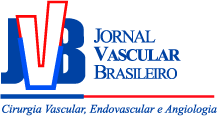Trombose induzida pelo calor endovenoso: relato de dois casos tratados com rivaroxabana e revisão da literatura
Endothermal heat-induced thrombosis (EHIT): reports on two case treated with rivaroxaban and literature review
Walter Junior Boim de Araujo; Jorge Rufino Ribas Timi; Fabiano Luiz Erzinger; Filipe Carlos Caron
Resumo
Palavras-chave
Abstract
Keywords
References
Min RJ, Khilnani N, Zimmet SE. Endovenous laser treatment of saphenous vein reflux: long-term results. J Vasc Interv Radiol. 2003;14(8):991-6.
Proebstle TM, Lehr HA, Kargl A. Endovenous treatment of the greater saphenous vein with a 940-nm diode laser: thrombotic occlusion after endoluminal thermal damage by laser-generated steam bubbles. J Vasc Surg. 2002;35(4):729-36.
Kane K, Fisher T, Bennett M. The incidence and outcome of endothermal heat-induced thrombosis after endovenous laser ablation. Ann Vasc Surg. 2014;28(7):1744-50.
Gonsalves WI, Pruthi RK, Patnaik MM. The new oral anticoagulants in clinical practice. Mayo Clin Proc. 2013;88(5):495-511.
Kabnick LS, Berland TL. Endovenous heat induced thrombosis (EHIT). 2011.
Rhee SJ, Stoughton J, Cantelmo NL. Procedural factors influencing the incidence of endovenous heat-induced thrombus (EHIT). J Vasc Surg. 2011;53(2):555.
Sadek M, Kabnick LS, Rockman CB. Increasing ablation distance peripheral to the saphenofemoral junction may result in a diminished rate of endothermal heat-induced thrombosis. J Vasc Surg. 2013;1(3):257-62.
Kabnick LS, Ombrellino M, Agis H. Endovenous heat induced thrombosis (EHIT) at the superficial deep venous junction: a new post-treatment clinical entity, classification and potential treatment strategies. 2006.
Lawrence PF, Chandra A, Wu M. Classification of proximal endovenous closure levels and treatment algorithm. J Vasc Surg. 2010;52(2):388-93.
Harlander-Locke M, Jimenez JC, Lawrence PF. Management of endovenous heat-induced thrombus using a classification system and treatment algorithm following segmental thermal ablation of the small saphenous vein. J Vasc Surg. 2013;58(2):427-31.
Harlander-Locke M, Jimenez JC, Lawrence PF, Derubertis BG, Rigberg DA, Gelabert HA. Endovenous ablation with concomitant phlebectomy is a safe and effective method of treatment for symptomatic patients with axial reflux and large incompetent tributaries. J Vasc Surg. 2013;58(1):166-72.
Geerts WH, Bergqvist D, Pineo GF. Prevention of venous thromboembolism: American College of Chest Physicians Evidence-Based Clinical Practice Guidelines (8th Edition). Chest. 2008;133(6^sSupl):381S-453S.
Bahl V, Hu HM, Henke PK, Wakefield TW, Campbell Jr DA, Caprini JA. A validation study of a retrospective venous thromboembolism risk scoring method. Ann Surg. 2010;251(2):344-50.
Sufian S, Arnez A, Labropoulos N, Lakhanpal S. Endovenous heat-induced thrombosis after ablation with 1470 nm laser: Incidence, progression, and risk factors. Phlebology. 2015;30(5):325-30.
Rosales-Velderrain A, Gloviczki P, Said SM, Hernandez MT, Canton LG, Kalra M. Pulmonary embolism after endovenous thermal ablation of the saphenous vein. Semin Vasc Surg. 2013;26(1):14-22.
Turpie AG, Lassen MR, Davidson BL. Rivaroxaban versus enoxaparin for thromboprophylaxis after total knee arthroplasty (RECORD4): a randomised trial. Lancet. 2009;373(9676):1673-80.
Bauersachs R, Berkowitz SD, Brenner B. Oral rivaroxaban for symptomatic venous thromboembolism. N Engl J Med. 2010;363(26):2499-510.
Werth S, Halbritter K, Mahlmann A, Weiss N. Treatment of an endovenous heat-induced thrombosis (EHIT) with rivaroxaban (Xarelto®). Phlebologie. 2015;44(4):184-7.
Gloviczki P, Comerota AJ, Dalsing MC. The care of patients with varicose veins and associated chronic venous diseases: clinical practice guidelines of the Society for Vascular Surgery and the American Venous Forum. J Vasc Surg. 2011;53(5^sSupl):2S-48S.



